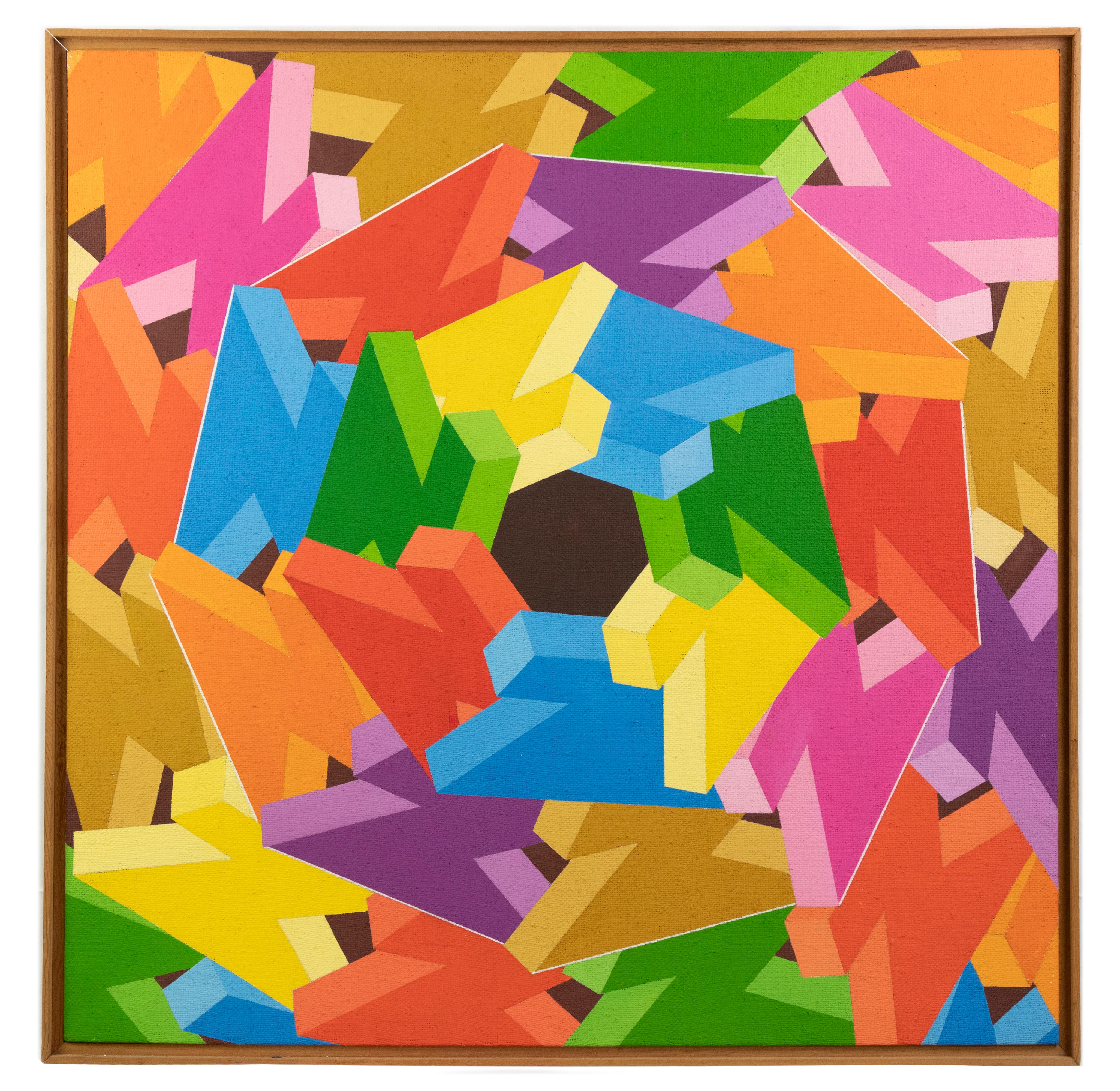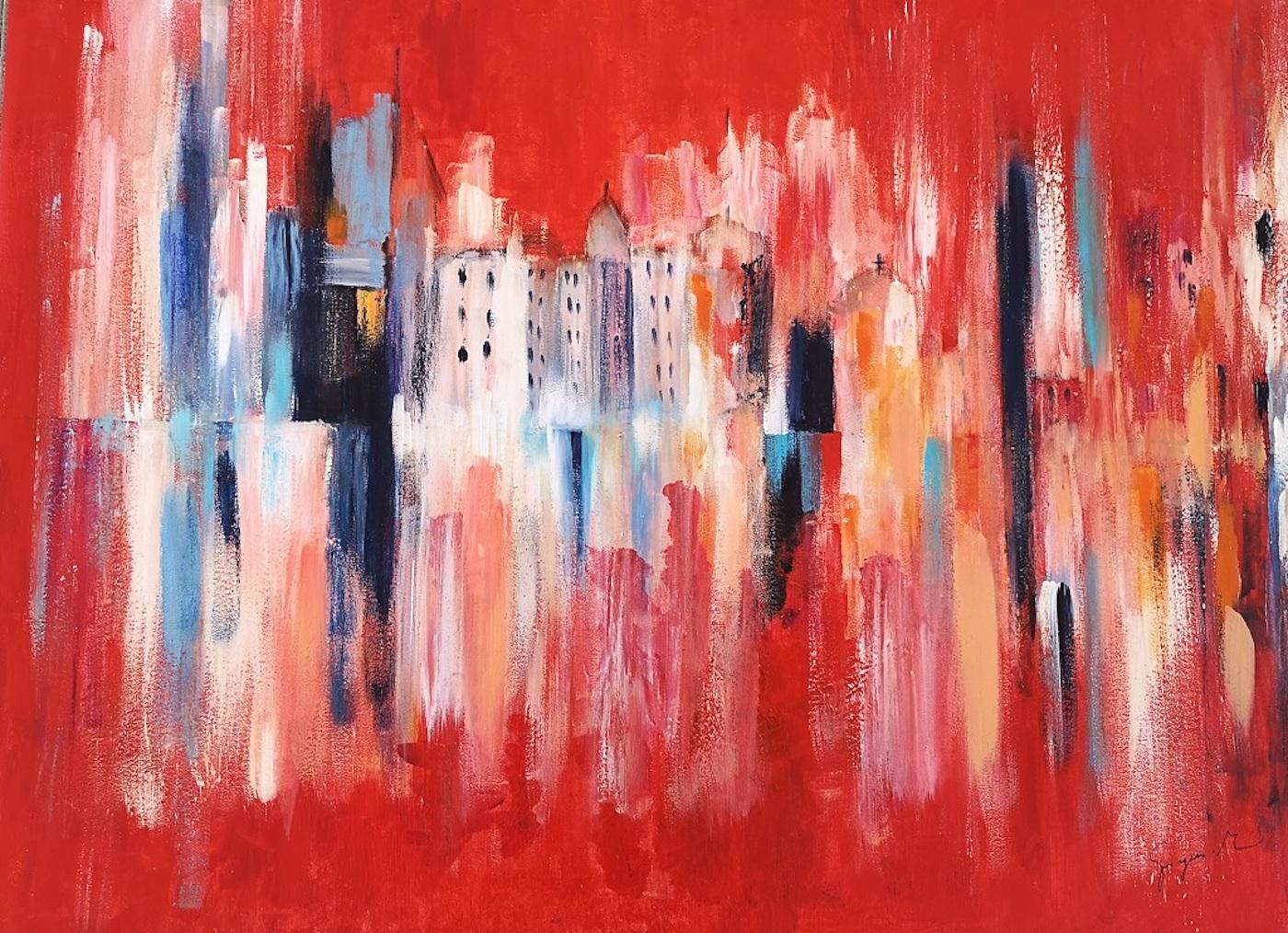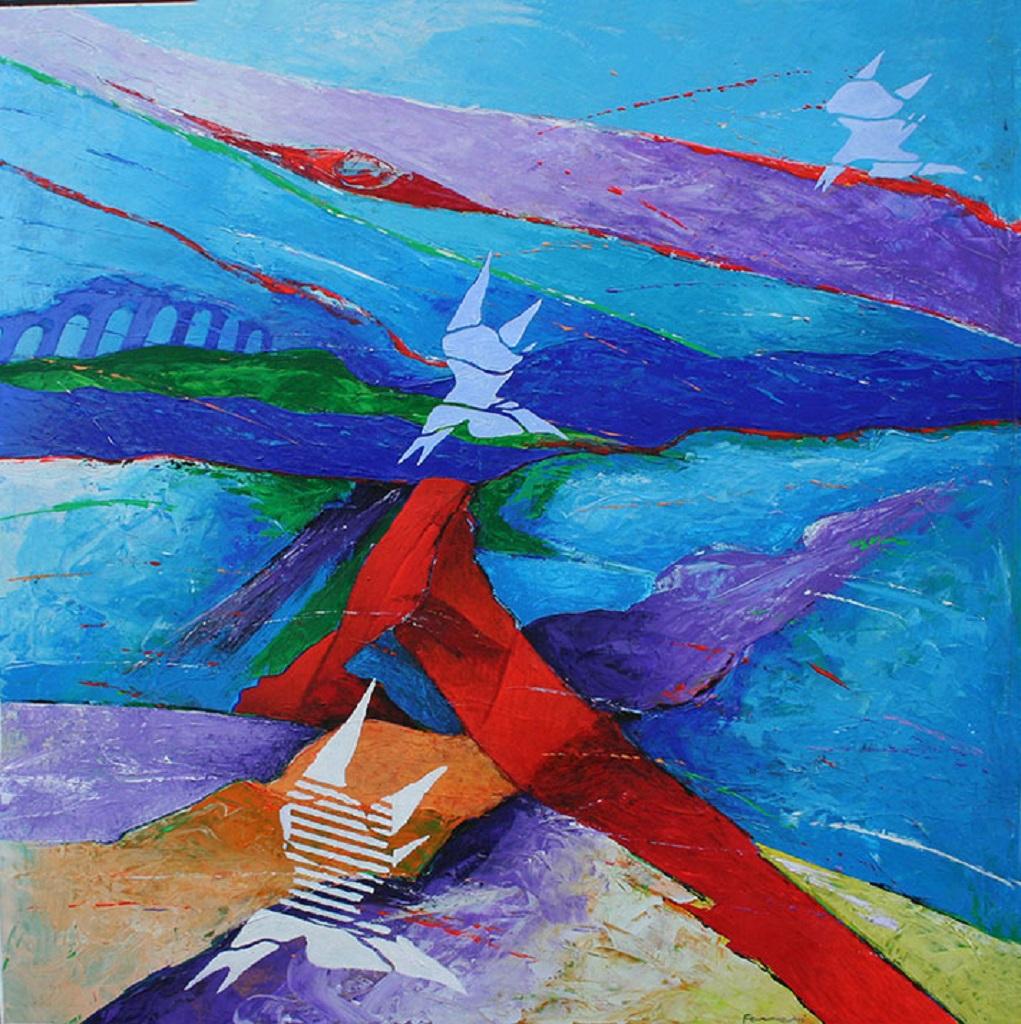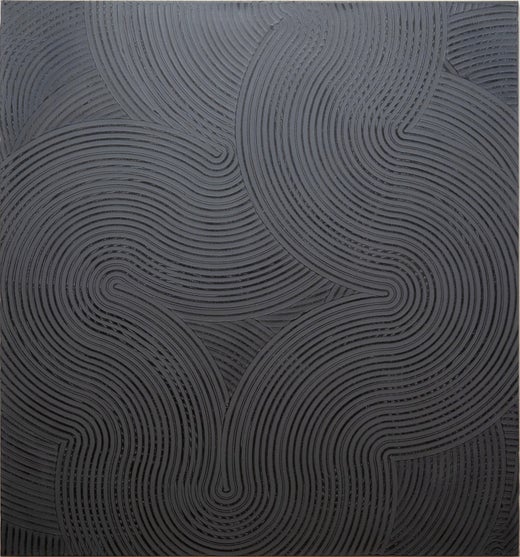Items Similar to Geometric Abstract Oil Painting Duanye Hatchett Original Modernist Early Work
Want more images or videos?
Request additional images or videos from the seller
1 of 9
Duanye HatchettGeometric Abstract Oil Painting Duanye Hatchett Original Modernist Early Work1994
1994
About the Item
An abstract painting by Duayne Hatchett from his Trowel Painting Series. Oil on canvas, circa 1990. Signed. Framed.
Duayne Hatchett was a visual artist whose work included prints, paintings, sculpture, and found objects. He was born on May 12, 1925 in Shawnee, Oklahoma. He enlisted in the Air Force where he trained to become a fighter pilot. After leaving the militrary he studied design at the University of Oklahoma. His highly technical military training combined a mathematical intelligence with a love for physics and a daring embrace of new experience, all of which would soon be the tools for his evolution through art.
Two major influences interacted on his early development at OU. Emelio Omero, a colleague and close friend of Diego Rivera, introduced him to the revolutionary art ideas of Mexico City, while teaching him a wide range of printing techniques that would culminate in a Masters Degree in Painting in 1952. During this time he met Bruce Goff, a renowned Wright disciple, who was teaching architecture at OU and befriended Hatchett, introducing him to the most avant-garde architecture of that time.
He spent his summers while at OU designing for a small sign shop, which introduced him to new materials used for building neon, plastic, and metal signs. The use of new materials and a keen sense for design would soon become invaluable building blocks for future sculpture. During this time he met and married Mary Ellen Jeffries. They would spend their lives together and raise three children, David (me), my brother Dana, and my sister Jeffri. As children, they were immersed in art from childhood and benefited greatly from this loving art and domestic environment.
Hatchett was always interested in the techniques of construction, often watching different tradesmen working, understanding how materials are put together to create the manmade environment that surrounded him. While teaching printmaking at Oklahoma City University from 1951 through ‘54, he began to build sculpture employing some of the materials and techniques that he saw workers using. He was beginning to draw the attention of architects and he became interested in their work-trade processes, moving from blue prints to construction. He accepted an invitation from Alexander Hogue to teach sculpture at Tulsa University in 1954. He moved his family to Tulsa where he would teach for the next ten years.
While in Tulsa, he became well known as a teacher and a sculptor, often lecturing at various sculpture conferences around the country. He also began to obtain commissions for sculpture as his interaction with architecture continued to evolve. He began to meet and interact with some of the most influential New York artists, including David Smith, Louise Nevelson, Noguchi, and Chicago artist, Richard Hunt.
The 'found object' became important subject matter for many artists including Hatchett and his frequent trips to junkyards yielded the materials for welded sculptures that explored abstract forms suggestive of the world around him. Sources of inspiration ranged from a dead cat smashed on the road to Sputnik orbiting the earth. Alan Stone Gallery in New York City, arranged to show two of these pieces at the Museum of Modern Art in 1963.
He was offered a teaching job at Ohio State University in 1964, where he would teach sculpture for the next three years, and make a leap of imagination that would propel his art into the museums and galleries in New York City and beyond. He began by moving away from combining found objects to using found materials to fabricate objects that he called "Totems." Royal Marks Gallery in New York City began to represent Hatchett in 1964 and arranged for him to be included in the ‘Young American Sculpture East to West’ show representing the United States in the 1964 New York World’s Fair. He would then leave any hint of the found object or junk material behind (until the 90’s) and move into pure abstraction, what can only be described as 'Modern' Art.
Taking his cue from modern architecture, he began to draw simplified volumes and planes, minimally rendered, so as to be easily grasped as a whole. Built with industrial materials, sheet metals and plastics, the images suggested the look of modern technology and architectural accuracy in the environment. These new works resulted in multiple one-person shows, including shows at Royal Marks Gallery in 1965, ’68, ’69, and ’70, and defined a major shift in his work that would be played out for the next two decades. He was featured on the cover of the Whitney Annual and the Whitney Museum acquired a large sculpture in 1967. He was included in the American Sculpture of the Sixties show at the Los Angeles County Museum and the Pittsburgh International, at the Carnegie Institute Museum of Art that same year.
In 1968 he took a teaching position at the University of Buffalo where he would head the sculpture department for the next 24 years and he would move his art in multiple directions. He began a series of paintings to exploit the simple line drawings previously used to define the plate metal sculpture. These paintings explored the optical relativity of two and three-dimensional space depicted on a flat plane. He was also continuing to develop his geometric minimalist sculptures, landing several sculpture commissions around the country. In 1974, the Albright-Knox Art Gallery in Buffalo, NY presented, Duayne Hatchett: Recent Paintings and Sculpture. In the ensuing years his work would be shown in one person and group shows around the country. In the studio, the confluence of construction and the 'Found Object' re-entered his work in a completely unexpected way. Construction itself became the creative engine transforming his new art.
New tools and working processes were adopted or invented to create new art. The trowel would replace the brush for building new paintings. Tools for rolling and burnishing metal would be invented and riveting would be adopted to build new sculptures. He was influenced by the characteristics of materials and objects such as corrugated sheet metals, the optical effects of plastics, metal grates, tin cans, seen in his man made environment, as well as crosscut tree logs and drift wood from his natural environment. He began to build sculptures, in the privacy of his studio, largely unseen by the public.
In the late 90’s, the found object re-emerged in the form of new sculpture created from railroad spikes welded together to form organic conglomerations reminiscent of nature. He also began to build assemblages of found objects and materials that maintained a continuous flat surface, which were simultaneously sculptures as well as being blocks for prints. By utilizing a wide range of printing techniques that he invented, he made mono-prints that record the image of the assembled material constructions, greatly extending his previous uses of the found object, and greatly expanding the imagery in his printmaking.
From printmaking and painting of the late 40’s, influenced by Mexican Art, through the junk metal used from found objects in the 50’s and early 60’s, through the minimalist sculpture and paintings influenced by modern architecture from the 60’s and 70’s, to the paintings, sculpture and printmaking of the last forty years, Duayne Hatchett has developed a personal expression that solicits a universal response. His unique visual language has been created through the invention of tools, the manipulation of various materials and objects, which he presents in a unified form. These expressions reflect our environment, specifically and generally, as objects once in use or patterns at play. Hatchett’s art works are interactive vessels that hold their content as potential energy, waiting to unlock our memories and our senses through the act of observation.
–David Hatchett, March 2009
Duayne passed away on September 7, 2015.
- Creator:Duanye Hatchett (1925 - 2015, American)
- Creation Year:1994
- Dimensions:Height: 18 in (45.72 cm)Width: 23 in (58.42 cm)Depth: 1 in (2.54 cm)
- Medium:
- Movement & Style:
- Period:
- Condition:
- Gallery Location:Buffalo, NY
- Reference Number:1stDibs: LU13929506492
Duanye Hatchett
Duayne Hatchett was a visual artist whose work included prints, paintings, sculpture, and found objects. He was born on May 12, 1925 in Shawnee, Oklahoma. He enlisted in the Air Force where he trained to become a fighter pilot. After leaving the military he studied design at the University of Oklahoma. His highly technical military training combined a mathematical intelligence with a love for physics and a daring embrace of new experience, all of which would soon be the tools for his evolution through art. He accepted an invitation from Alexander Hogue to teach sculpture at Tulsa University in 1954. He moved his family to Tulsa where he would teach for the next ten years. While in Tulsa, he became well known as a teacher and a sculptor, often lecturing at various sculpture conferences around the country. He also began to obtain commissions for sculpture as his interaction with architecture continued to evolve. He began to meet and interact with some of the most influential New York artists, including David Smith, Louise Nevelson, Noguchi, and Chicago artist, Richard Hunt. In 1968 he took a teaching position at the University of Buffalo where he would head the sculpture department for the next 24 years and he would move his art in multiple directions. He began a series of paintings to exploit the simple line drawings previously used to define the plate metal sculpture. These paintings explored the optical relativity of two and three-dimensional space depicted on a flat plane. He was also continuing to develop his geometric minimalist sculptures, landing several sculpture commissions around the country. In 1974, the Albright-Knox Art Gallery in Buffalo, NY presented, Duayne Hatchett: Recent Paintings and Sculpture. In the ensuing years his work would be shown in one person and group shows around the country. In the studio, the confluence of construction and the 'Found Object' re-entered his work in a completely unexpected way. Construction itself became the creative engine transforming his new art. New tools and working processes were adopted or invented to create new art. The trowel would replace the brush for building new paintings. Tools for rolling and burnishing metal would be invented and riveting would be adopted to build new sculptures. He was influenced by the characteristics of materials and objects such as corrugated sheet metals, the optical effects of plastics, metal grates, tin cans, seen in his man made environment, as well as crosscut tree logs and drift wood from his natural environment. He began to build sculptures, in the privacy of his studio, largely unseen by the public. In the late 90’s, the found object re-emerged in the form of new sculpture created from railroad spikes welded together to form organic conglomerations reminiscent of nature. He also began to build assemblages of found objects and materials that maintained a continuous flat surface, which were simultaneously sculptures as well as being blocks for prints.
About the Seller
4.9
Platinum Seller
These expertly vetted sellers are 1stDibs' most experienced sellers and are rated highest by our customers.
Established in 1970
1stDibs seller since 2015
2,385 sales on 1stDibs
Typical response time: 1 hour
- ShippingRetrieving quote...Ships From: Brooklyn, NY
- Return PolicyA return for this item may be initiated within 2 days of delivery.
More From This SellerView All
- A Set of 12 Contemporary Framed Abstract Paintings Blue White Museum CollectionBy Monica AngleLocated in Buffalo, NYA set of 12 original mixed media monotype and painting mixed media works by American contemporary artist Monica Angle. These pieces were inspired by the changing light throughout th...Category
2010s Abstract Expressionist Abstract Paintings
MaterialsCanvas, Paper, Acrylic, Watercolor
- Giverny GardenBy Rebecca AllanLocated in Buffalo, NYThis dynamic painting by contemporary artist Rebecca Allan may be hung in a variety of orientations. Rebecca Allan is a New York-based visual artist known for her richly layered and...Category
Early 2000s Abstract Abstract Paintings
MaterialsCanvas, Acrylic
- Volcanic Landscape MauiBy Rebecca AllanLocated in Buffalo, NYThis dynamic painting by contemporary artist Rebecca Allan may be hung in a variety of orientations. Rebecca Allan is a New York-based visual artist known for her richly layered and...Category
Early 2000s Abstract Abstract Paintings
MaterialsCanvas, Acrylic
- Travel as Equals, ( by Joseph Arthur)By Felice KoenigLocated in Buffalo, NYAn original acrylic on canvas painting by American contemporary female artist Felice Koenig. This piece is part of the artists series of works paired with pieces of music. The score and sound of the work directly inspires the particular pattern and color of the painting. This painting is inspired by the song "Travel as Equals" by Joseph Arthur.Category
2010s Abstract Abstract Paintings
MaterialsCanvas, Acrylic
- Huge Mid Century Modern Texas Artist Abstract Expressionist Minimalist PaintingBy Duanye HatchettLocated in Buffalo, NYAn abstract expressionist painting by Duayne Hatchett . Oil on canvas, circa 1990. Signed verso. Framed. Image size, 60"H x 55"L. Duayne Hatchett was a visual artist whose work...Category
1990s Abstract Abstract Paintings
MaterialsCanvas, Acrylic
- Huge Mid Century Modern Texas Artist Geometric Abstract Minimalist Oil PaintingBy Duanye HatchettLocated in Buffalo, NYAn abstract, minimalist painting by Duayne Hatchett . Oil on canvas, circa 1973. Signed verso. Framed. Image size, 60"H x 50"L. Duayne Hatchett was a visual artist whose work i...Category
1970s Abstract Abstract Paintings
MaterialsCanvas, Acrylic
You May Also Like
- Vertigo - Acrylic on Canvas by Franco Giuli - 1989/90Located in Roma, ITVertigo is a colorful artwork realized by the Italian artist Franco Giuli during the 1989-1990. Acrylic on canvas. Artwork exhibited on the occasion of ...Category
1980s Abstract Abstract Paintings
MaterialsCanvas, Acrylic
- Give Me ShelterLocated in Toronto, CAAlexander Rasmussen’s “Better Days Are Comin’.” This vibrant new series of abstracts was presented in part at Art Miami 2023, and the remaining pieces are now being exhibited for the...Category
2010s Abstract Abstract Paintings
MaterialsCanvas, Oil, Acrylic
- Landscape in Red - Acrylic on Canvas by M. Goeyens - 2014By Martine GoeyensLocated in Roma, ITLandscape in Red is a suggestive artwork realized by the Belgian artist Martine Goeyens in 2014. Acrylic on canvas. Hand-signed on the lower right ma...Category
2010s Abstract Abstract Paintings
MaterialsCanvas, Acrylic
- Battle 2 - Acrylic and Oil by Leo Guida - 1992By Leo GuidaLocated in Roma, ITBattle 2 (Original Title: Battaglia 2) is an original Contemporary artwork realized in 1992 by the italian Contemporary artist Leo Guida (1992 - 2017). Original Acrylic and oil on c...Category
1990s Abstract Abstract Paintings
MaterialsCanvas, Oil, Acrylic
- From Afar - Painting by Franco Ferrari - 2000sLocated in Roma, ITFrom Afar is an original contemporary artwork realized in the 2000s by the Italian Contemporary artist Franco Ferrari. Original mixed media painting. Acrylic on canvas. Original t...Category
Early 2000s Abstract Abstract Paintings
MaterialsCanvas, Acrylic
- Roman Landscape - Painting by Franco Ferrari - 2000sLocated in Roma, ITRoman Landscape is an original contemporary artwork realized in the 2000s by the Italian Contemporary artist Franco Ferrari. Original mixed media painting. Acrylic on canvas. Orig...Category
Early 2000s Abstract Abstract Paintings
MaterialsCanvas, Acrylic
Recently Viewed
View AllMore Ways To Browse
Vintage Work Shop
Weld Work
Mexican Metal Work
Plate Abstract Design
Geometric Abstract Metal Art
Oil On Tin
1994 Watch
Large Abstract Vessel
70s Modernist
Cat Subject Painting
Engine Frame
Vintage Tool Shop
Vintage Tools Shop
Large Metal Art Geometric
Large Original Line Drawing
Original Line Drawing Large
Vintage Tool Watch
Retro Watch Tools






